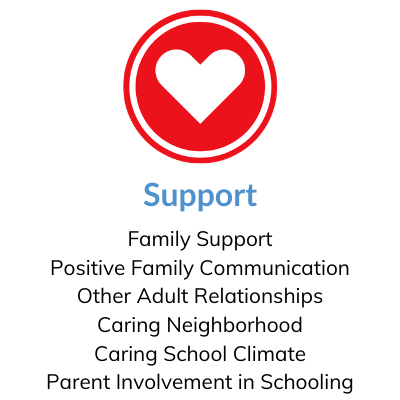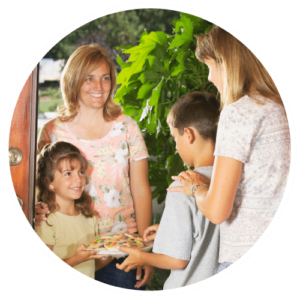Developmental Asset Categories
External Assets: Support | Empowerment | Boundaries & Expectations | Constructive Use of Time
Internal Assets: Commitment to Learning | Positive Values | Social Competencies | Positive Identity
External Assets: Support | Empowerment | Boundaries & Expectations | Constructive Use of Time
Internal Assets: Commitment to Learning | Positive Values | Social Competencies | Positive Identity
Many studies over the years confirm that caring, supportive relationships with adults are critical for raising young people who are healthy and resilient. Support means freely giving young people love, affirmation, and acceptance; surrounding young people with caring families, guardians, friends, teachers, neighbors, and other adults; and helping young people know they belong, are not alone, and are both loved and lovable. Support is one of eight asset categories that make up Search Institute’s 40 Developmental Assets, the qualities, experiences, and relationships that help young people grow up healthy, caring, and responsible.
Research shows that the more loving, supportive, and caring adults a young person knows, the more likely he or she is to grow up healthy. Search Institute has identified six assets in the Support category crucial for helping young people grow up healthy: Family Support, Positive Family Communication, Other Adult Relationships, Caring Neighborhood, Caring School Climate, and Parent Involvement in Schooling.

Share your ideas for building these assets using @ShelteringWings and #SW40Assets.
Young people need to be surrounded by people who love, care for, appreciate and accept them.
 Family life provides high levels of love and support, the family foundation.
Family life provides high levels of love and support, the family foundation.You can show the children in your family that you love and support them in many ways. When you hug them or say, “I love you,” the sentiment is obvious. Paying attention to them, listening to them, and taking an interest in what they’re doing are less noticeable ways of giving support. After all, does your child feel supported when you come home from an exhausting day, and he or she wants to talk—but you want a break? The young people closest to you know your body language. They listen to what you say—and don’t say. They notice when your words and actions don’t match. Make it a point to be sure they hear your message of love and support loud and clear at all times.
Research shows that young people are more likely to grow up healthy when their families provide them with high levels of love and support. It’s important for parents and guardians to create a home environment that fosters loving words and actions, consistency and openness. About 68 percent of young people, ages 11–18, say their family life provides high levels of love and support. Spending quality time together is the first—and most important—step toward establishing a great family support system.
Be consistent. Be loving. Develop openness so that the children in your family know that you’re available and you’ll love them—no matter what. If you’re exhausted or angry, say so. Tell children what you’re feeling so that your body language and words are consistent. Inconsistent messages are often misinterpreted by youth to mean that they have done something wrong.
In your home and family: Spend one hour a week alone with each of your children. Take a walk, listen to music, cook together, or just hang out.
In your neighborhood and community: Try to arrange a babysitting swap with a neighbor. It’s important for parents and guardians to have time away from children, doing things they enjoy alone and with other adults. This will make family time that much sweeter.
In your school or youth program: Assign students and participants activities that encourage family sharing. For example, one Minnesota class studying a Native American tribe learned that tribal members passed down stories from one generation to the next. The teacher assigned students to ask their parents for family stories to share with the class.
 The importance of an open door
The importance of an open doorSometimes conversations with young people—especially your own children—can become confrontational. Learning to listen can help prevent slamming doors and, instead, open them. Though challenging, being available for frequent, in-depth conversations is an important role parents and other adult family members can play in children’s lives—from the time they learn to talk all the way into adulthood. The goal is to promote and maintain an open-door policy. Ask open-ended questions and then listen, listen, listen.
Research shows that young people who experience positive communication with their parents are more likely to grow up healthy and are more willing to seek their parents’ advice and counsel. About 28 percent of young people, ages 11–18, enjoy positive communication with their parents and are willing to seek their parents’ counsel and advice, according to Search Institute surveys. Practice consistently communicating—talking and listening to young people—with an open mind and heart.
Positive communication also means listening to understand a young person’s perspective, not to advocate your position. Be available when young people need you—and even when they think they don’t. Take good care of yourself so when your children want to talk, you can give them your full attention.
In your home and family: Make it easy for your child to spend time talking with you: Keep an extra stool or chair in the kitchen, den, home office, or workshop area. When you’re in the car together is a great time to chat, too.
In your neighborhood and community: Ask young people you know caring questions, such as: What was the best thing about school today? What was the best act in the talent show? Why? Listen to their answers and respond accordingly.
In your school or youth program: During parent meetings, discuss the importance of positive communication between parents and children.
 When times get tough, kids need adults they can trust
When times get tough, kids need adults they can trustWho did you turn to for advice, comfort, and understanding when you were young? Was there an adult you trusted and enjoyed talking with? If you had an adult outside your family who was there for you during tough times and good times, you probably understand how important a relationship like that is for a young person. Now you can be that adult friend. Whether you’re a neighbor, teacher, tutor, coach, aunt, older cousin, or coffee shop worker—you can be a good friend to a young person. Young people want adults besides their parents to count on. Problem is, we live in a society that doesn’t always encourage adults and youth to spend time together. But the effort is worthwhile.
Research shows that young people who have three or more caring adults (besides parents or guardians) who support them feel happier and more hopeful, do better in school, and are less likely to rely on drinking, smoking, or drugs to feel good or fit in. About 43 percent of young people, ages 11–18, have three or more nonparent adults in their lives, according to Search Institute surveys. Caring adults are important to the development of young people, especially if those adults are open to discussing tough questions and know how to listen without judging.
Build relationships. Connect with young people outside your own family and make an effort to interact regularly. They need caring adults to bounce ideas off, ask questions of, laugh with, and help sort through sticky situations. If you’re a parent, encourage other caring adults to develop a friendship with your children.
In your home and family: Think about your child’s strengths, talents, and interests. Do you know any adults who share those same qualities? Invite one of them to get to know your child better by coming to a school activity or getting together for dessert or a movie.
In your neighborhood and community: Consider becoming a mentor to one or more young people in your community.
In your school or youth program: Tell young people about an adult who supported you when you were young. Ask them to think about someone they counted on during a tough time. Have the young people pair up and brainstorm ways they could initiate more friendships with other caring adults and what they’d want to get from these relationships.
 Reach out to those around you
Reach out to those around youDo you remember coming home from school and running through the neighborhood at a thundering speed, playing catch with your pals, and having a last-minute pizza dinner with your best friend’s family? Past generations have enjoyed much more freedom and safety than young people today. In a bygone era, if you got hurt, in trouble, or lost near your home, you felt safe because you knew your neighbors and had only to turn to one of them for help or reassurance. It’s important for the well-being of young people and society to reach out to one another and get to know neighbors.
Research shows that young people are more likely to grow up healthy if they live in a community with caring neighbors. About 37 percent of young people, ages 11–18, report that they have caring neighbors, according to Search Institute surveys.
The key is to create a safe haven in which young people feel loved, supported, and understood.
Friendships and trust only develop when people take risks by acknowledging their neighbors, getting to know them, and taking time to form relationships. How well do you know your neighbors? Do you know their names? Get to know those who live around you. Begin by greeting your neighbors when you see them outside. With a little effort, you’ll get to know the young people you live near and they’ll get to know you.
In your home and family: Encourage your child to get to know the people in your neighborhood by being a role model. Walk through the neighborhood as a family. Organize a potluck, cookout, or block party with your neighbors.
In your neighborhood and community: Meet with a neighborhood group or start a small group if one doesn’t exist. Do activities together, such as creating a community garden or forming a “welcome wagon” of youth and adults to greet new residents.
In your school or youth program: Create a magazine or book about local history. To do so, ask students or participants to interview some of the older neighbors and collect their stories.
 Every place has a climate, even a classroom
Every place has a climate, even a classroomThe way young people feel about going to school and how well they learn is directly tied to what kind of “climate” their school has. If a school feels “warm” in a caring way, it’s easier for students to learn. But if safety at school is a problem or relationships between students and teachers are tense, it’s more difficult for everyone to focus on learning. A healthy climate enables students, teachers, staff, and parents to all take pride in their school.
Research shows that young people who go to school where the environment feels caring and encouraging get better grades, have healthier relationships, get into less trouble, and are interested in and better able to reach their dreams. Only 29 percent of young people say their school provides a caring, encouraging environment, according to Search Institute surveys. Maybe we can’t stop the rain, lower the humidity, or make it snow, but we do have the power to change the climate at our schools.
Young people come in contact with a lot of different adults during the day. One person’s attitude—good or bad—can significantly impact how students feel about themselves and interact with others at school. For young people, the day may start with a greeting from the bus driver. When school secretaries, counselors, teachers, coaches, custodians, parent volunteers, and others take time to relate to young people in a positive, caring, and supportive way, school is a great place to be.
In your home and family: Talk with your child about the “feel” of his or her school. Advocate through the PTA or school leadership for caring relationships, as well as high academic expectations. Both are important!
In your neighborhood and community: Volunteer at your local school. If students or faculty express negative or ambivalent mindsets, ask them why. Do your part to improve the climate by keeping a positive, sunny attitude.
In your school or youth program: On the board or on a large piece of paper, sketch a map of your school. Have students or participants mark the places where the climate feels warm and caring. Brainstorm ways to move a “warm front” into “cold” places.
 Get involved, stay involved
Get involved, stay involvedWhen children start kindergarten, most parents are quite involved with their education. They attend parent-teacher conferences, cheer on their children at school concerts, and proudly display their children’s artwork. But far too often, parents begin to distance themselves from their children’s schooling as the kids grow older. The involvement drops dramatically once young people enter middle and high school—in some respects the most difficult time for young people. Parents don’t have to go to school every day or even volunteer monthly, but it’s important to know what’s going on with their children’s education.
Research shows that young people are more likely to grow up healthy when their parents are involved in their education. Only 29 percent of young people, ages 11–18, say their parent(s) are actively involved in helping them succeed in school, according to Search Institute surveys. Remember, even if they don’t always show it, young people need your help with school. Check in with your kids to see how they feel things are going with school—and make sure to communicate regularly with teachers as well.
Young people need their parents to stay actively involved in their education throughout middle and high school. If you’re a parent, introduce yourself to your child’s teachers and establish clear, open communication. Attend all teacher-parent conferences, or reschedule a more convenient time if needed. If possible, volunteer in small ways, such as speaking on career day or setting up for a classroom party. Also, talk to your child about school. Ask him or her about current assignments and projects. Be available to help when your child needs it. If you’re a teacher, reach out to parents and engage them as partners in their children’s education.
In your home and family: Maintain ongoing communication with your child’s teachers. Call or e-mail to check in every other month—or more often if necessary.
In your neighborhood and community: Join a parent-teacher organization. If your time is limited for volunteering do what you can when you can.
In your school: Offer parents easy, convenient ways to get involved in their children’s education. For example, tutoring students before exams may be perfect for parents who can’t make an ongoing commitment. For parents who miss conferences, try calling them to find out what’s keeping them from attending. See if you can work out a way to get together or by phone discuss their child’s progress.
Developing bonds with young people takes listening and giving of yourself as needed. Be patient. Different kids and situations call for different kinds of support. Comfort, encourage, and help young people. Or simply be there for them. Remember that support doesn’t have to be big or loud to be meaningful.
In your home and family: Have each family member name three ways the family supports her or him. Discuss these, as well as the areas (and ways) in which each family member would like to receive more support.
In your neighborhood and community: Model support for young people by being supportive toward others in your neighborhood, both youth and adults—praise them, take time for them, show an interest in them, and work to understand them.
In your school or youth program: Encourage access to at least one caring adult for each young person in the school or youth program.